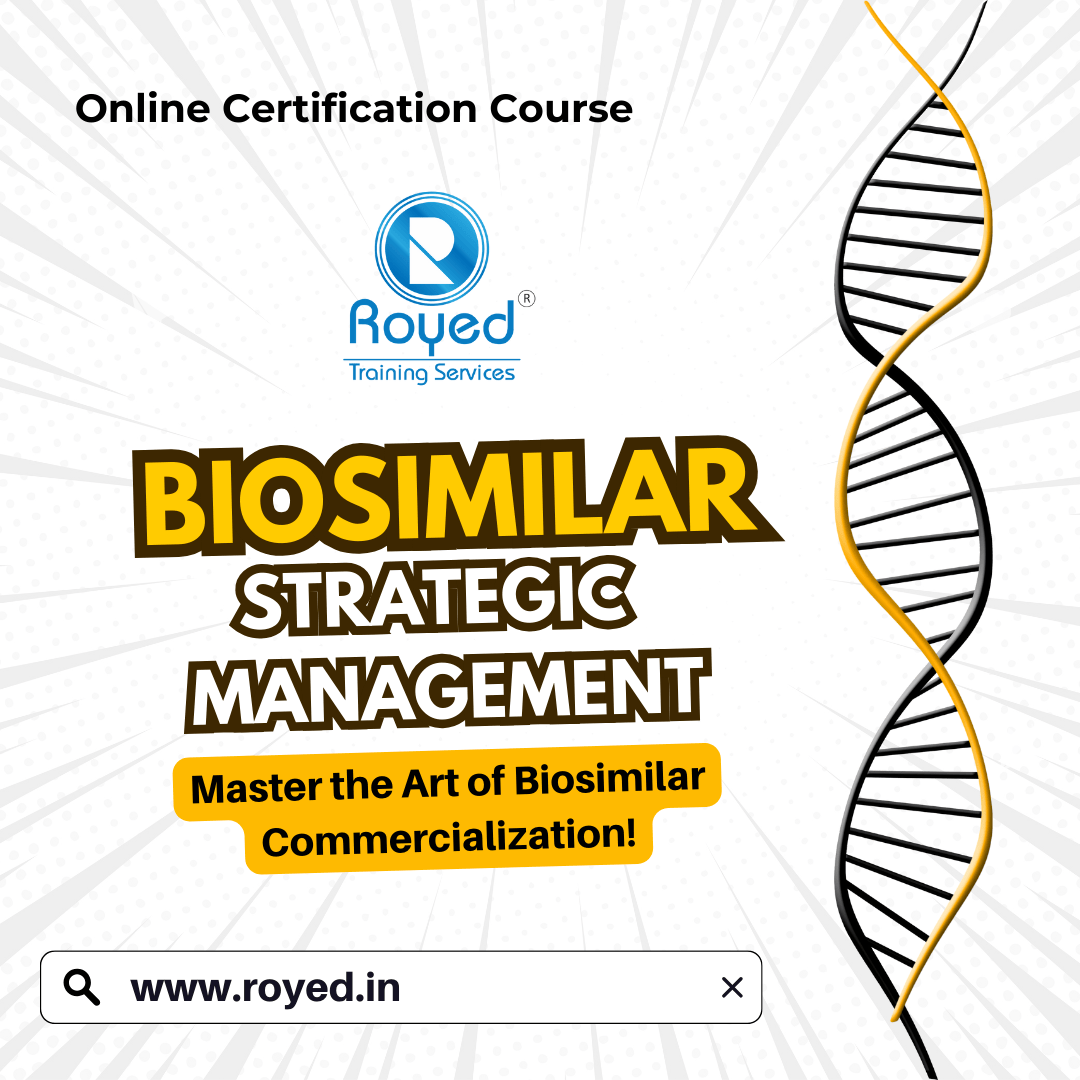
Introduction
Features
Core Learning Areas
Related Courses
About Pharma Management
Add on Certification

Royed Training’s Advanced Certification in Biosimilar Strategic Management is a specialized, in-depth training program designed to provide a 360-degree perspective on the biosimilar product journey — from scientific development to global regulatory approval, production optimization, and ultimately, successful commercialization and market access.
With the biosimilar market evolving rapidly and becoming a cornerstone of global biopharmaceutical strategies, there is a growing demand for professionals who can navigate the complex, multi-functional landscape of biosimilar strategic planning. This course fills that gap by offering practical, real-world learning combined with interactive simulations and case-based scenarios.
Who should attend this course?
- Biopharmaceutical professionals in R&D, Regulatory Affairs, Market Access, Business Development
- Strategic Planners, Project Managers, and Brand Managers
- Entrepreneurs or consultants involved in biosimilar businesses
- Graduates seeking specialized skills in biopharma strategy
Course Snapshot
- Course Code: RYD-131
- Title: Advanced Certification in Biosimilar Strategic Management (ACBSM)
- Type of the course: Self paced Online Course. Hence this course can be accessed online across anywhere 24×7. Moreover, you can attend the course at your convenience in your flexible time. For example, if you want to attend the session at 11 pm at night, you can do that.
- Course Duration : 1 Month
- Course Certification: Certificate will be provided at the end of the successful completion of the course.
Course Features of Biosimilar Strategic Management
- 100% Online and Self-Paced: Access the course anytime, anywhere with complete flexibility to learn at your own pace.
- Biosimilar Product Class Training: Detailed modules covering various biosimilar classes like monoclonal antibodies, insulins, erythropoietin, growth hormones, etc., and how their development and approval pathways differ.
- Real-World Case Studies: Learn through actual biosimilar success and failure stories across regions and product categories to understand strategic challenges and winning models.
- Hands-On Simulations: Engage in interactive simulation exercises — including regulatory planning, pricing strategy, and launch execution — designed to mimic real-life business scenarios.
- Regulatory Intelligence Coverage: Stay updated with comprehensive insights into biosimilar regulations in US, EU, WHO, GCC, LATAM, ASEAN, and emerging markets.
- Strategic Planning Tools: Downloadable frameworks and tools for regulatory planning, market access assessment, pricing models, and launch readiness.
- Expert-Curated Modules: Content developed and reviewed by seasoned professionals from biopharma regulatory, manufacturing, and commercial domains.
- Course Progress Tracker and Analytics: Personalized dashboard to monitor learning progress, quiz performance, and module completion.
Key Learning Highlights:
- Biosimilar Development: Explore the scientific, technical, and clinical requirements for biosimilar development including analytical characterization and comparability exercises.
- Regulatory Pathways: Deep dive into global regulatory frameworks such as US FDA, EMA, WHO, and emerging markets for biosimilar approvals.
- Production Strategy: Understand manufacturing scale-up, QbD, and cost-effective production planning for biosimilars.
- Market Access & Strategic Planning: Learn real-world techniques in pricing, tendering, HTA evaluations, payer engagement, and market differentiation strategies.
- Business Simulation and Case Studies: Apply learning to simulated launch scenarios, regulatory hurdles, and go-to-market challenges.
Few other courses on Biologics
- Biosimilar Patent Dance
- Biopharmaceutical Regulatory Affairs
- Biopharma Global Business
- Project Management in Biopahrmaceutical Industry
- Business Development and Licensing in Biopharmaceutical industry
- Biopharmaceutical Medical Representative Selling Skill Training
- Basics of Biopharma
- Biologic Business and Brand Valuation
- Biopharma Market Access & Pricing
Career in Biopharma Global Business
One of the fastest growing industries in is biopharmaceuticals. Hence the job market offers multiple opportunities for life science professionals as biotech companies work everyday to create successful products and place them in the marketplace. In biopharmaceutical industry scientists and researchers are key people who always preferred because of their biopharma subject knowledge. While these individuals have the academic and scientific background, they may not have the strategic management skills to manage biopharmaceutical business. Hence, this course provides necessary training to skill up the biopharmaceutical professionals.
In biopharmaceutical industry, strategic manager oversee the process of discovery, development and commercialization. They determine the biopharmaceutical products scope, timelines, budget and procurement, market access, regulatory, quality controls, marketing strategies, etc.
What are the areas biopharma global business professionals can make a career in biopharmaceutical company?
Biopharmaceutical Global Business Professionals will have option to join or work in following departments :
- R&D Project Management
- Strategic Management
- Market Access
- Global Pricing
- Regulatory Affairs
- Business Development
- Licensing Department (Inlicensing or Outlicensing)
- Brand Management
- Marketing and Sales Management
Specific Knowledge of the various business regions is important for biopharmaceutical business management
There is no doubt that the biopharmaceutical industry is growing at a rapid pace. In fact Biologic is the future of medicine. However there is a rising concern over the safety and efficacy. Hence, the major objective of the biopharmaceutical management professionals is to learn various regional regulatory and business development knowledge. In fact, regional biopharma knowledge will help them to become successful in international business management. Moreover, the biopharma business development landscape is evolving and changing every other day. Biopharma management professionals must have thorough knowledge about the updated regulations. Sound regulatory knowledge helps them to take strategic decisions effectively. Therefore, this course is an ideal choice for the biopharmaceutical management course which covers various domains.
Add on Certification
- The participants of Global Business Registrant will get two add-on certifications.
- Hence participants can choose add on courses of any 1 month or 1 week / 3 Days certification course. One can choose the desired course from the following course list.
- Participants can activate the add on course anytime during 1 year active course duration.
- On completion of the add-on course, participants will be issued a course certificate. Hence, apart from the biopharma global management certification, participants will receive 2 add-on course certificates without any additional cost.
- You can activate this add on course anytime during the active 1 year course tenure.


